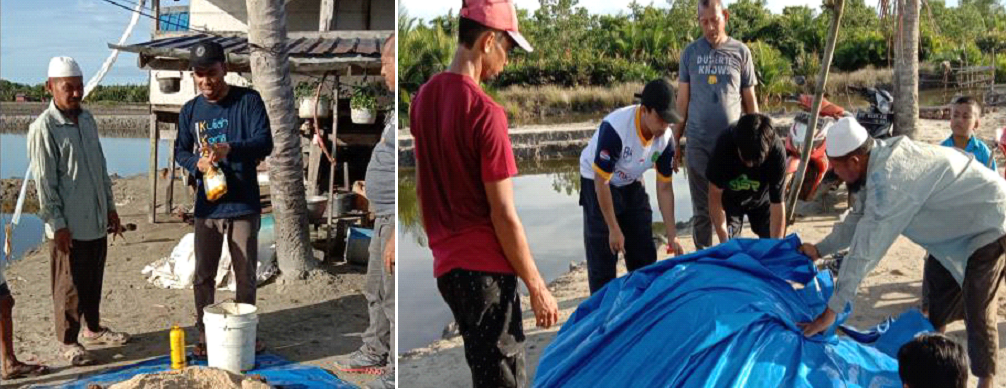Agribisnis Bandeng Organik Organic Milkfish Agribusiness
Main Article Content
Abstract
Empowerment of coastal communities is a must because of the many limitations, causing backwardness, especially economically. The specific objective of this program is to realize a pond farming business that has high productivity at low cost and is environmentally friendly so that farming sustainability can be realized, in addition to realizing a farming system with proper management, both production management and institutional and financial management. The method that will be used to achieve this goal is to provide group management and business management training. Business management training is carried out to provide an understanding of the advantages of organic pond cultivation and is also carried out directly in real business. Activities are carried out simultaneously by the group members involved in the planned stages and guided by field staff and the implementing team. The technical stage of its implementation is that the seeds purchased from the hatchery are maintained in a smelting pond for one month. Previously, soil turning, drying, liming, and applying organic fertilizer were carried out. On the other hand, this farmer group can implicitly know and carry out organic farming/fishery activities so that they have supported the government's program on environmentally friendly organic and sustainable farming (Go-Organic).
Downloads
Article Details

This work is licensed under a Creative Commons Attribution-ShareAlike 4.0 International License.
Authors who publish with this journal agree to the following terms:
- Any article on the copyright is retained by the author(s).
- Author grant the journal, right of first publication with the work simultaneously licensed under a Creative Commons Attribution License that allows others to share work with acknowledgment of the work authors and initial publications in this journal.
- Authors are able to enter into a separate, additional contractual arrangements for non-exclusive distribution of published articles of work (eg, post-institutional repository) or publish it in a book, with acknowledgment of its initial publication in this journal.
- Authors are permitted and encouraged to post their work online (e.g., in institutional repositories or on their websites) prior to and during the submission process, as can lead to productive exchanges, as well as earlier and greater citation of published work.
- The article and any associated published material is distributed under the Creative Commons Attribution-ShareAlike 4.0 International License
References
Azis, A. & Nuryadi, A. M. (2014). Model Pengentasan Kemiskinan Masyarakat Pesisir melalui Pengembangan Usaha Tambak Rakyak. Laporan Penelitian. Kendari: Universitas Halu Oleo.
Azis, A. (1998). Kajian Pengembangan Usahatani Tambak pada Desa-desa Pantai di Provinsi Sulawesi Tenggara. Laporan Penelitian. Kendari: Universitas Halu Oleo.
Dinas Kelautan dan Perikanan Sulawesi Tenggara. (2020). Statistik Perikanan Budidaya Provinsi Sulawesi Tenggara, 2005 dan 2014. Kendari: Dinas Kelautan dan Perikanan Sulawesi Tenggara.
Malik, A. (2010). Pengaruh pemberian Suplemen dan Probiotik Terhadap Hasil panen bandeng di Wilayah desa Kentong Kecamatan Glagah Kabupaten lamongan. GROUPER Jurnal Ilmiah Fakultas Perikanan Universitas Islam Lamongan, 1(1), 57-65. https://doi.org/10.30736/grouper.v1i1.7
Mangampa, M. & Suwoyo, H. S. (2010). Budidaya Udang Vaname (Litopenaeus vannamei) Teknologi Intensif Menggunakan Benih Tokolan. Jurnal Riset Akuakultur, 5(3), 351-361. http://dx.doi.org/10.15578/jra.5.3.2010.351-361
Muntali & Mas’ud, F. (2014). Pengembangan Budidaya dan Teknologi Pengolahan Ikan Bandeng (Chanos-Chanos Forscal) di Kabupaten Lamongan Guna meningkatkan Nilai Tambah. Jurnal Eksakta, 2(1), 54-88.
Murdani, Widayani S., & Hadromi. (2018). Pengembangan Ekonomi Masyarakat Melalui Pemberdayaan Usaha Mikro Kecil dan Menengah (Studi di Kelurahan Kandri Kecamatan Gunungpati Kota Semarang). ABDIMAS, 23(2), 152-157. http://dx.doi.org/10.15294/abdimas.v23i2.17893
Musadar. (2021). Economic Empowerment Model for Freshwater Aquaculture-Based Communities in South Konawe Regency. The International Journal of Engineering and Science (IJES), 10(11), 1-6. https://doi.org/10.9790/1813-1011020106
Muthalib, A. A., Nuryadi, A. M., & Almana, L. O. (2015). Poverty Alleviation through Community Empowerment Based Farming Ponds in Coastal Areas Southeast Sulawesi. The International Journal of Engineering and Science (IJES), 4(10), 32-40.
Notohadiningrat & Tejoyuwono. (1995). Revolusi Hijau dan Konservasi Tanah, Materi Diskusi Panel Pengembangan Pertanian Berwawasan Lingkungan Ditinjau dari Aspek Ilmu Pengetahuan dan Sosial Ekonomi dalam Rangka Peningkatan Kesejahteraan Petani. Laporan Penelitian. Surakarta: Universitas Sebelas Maret.
Nuryadi, A. M. (2015). Analisis Perbandingan Keuntungan Budidaya Monokultur Bandeng dan Dikutur Udang Bandeng pada Usahatani Tambak Rakyat di Kabupaten Bombana. Phinisi, 9(1), 1-6.
Nuryadi A. M., Sara L., Rianda L., & Bafadal A. (2019). A model for developing seaweed agribusiness in South Konawe, Southeast Sulawesi, Indonesia. AACL Bioflux, 12(5), 1718-1725.
